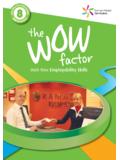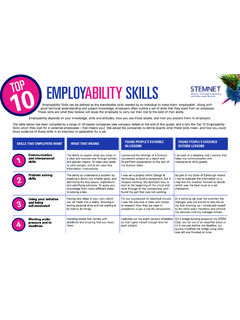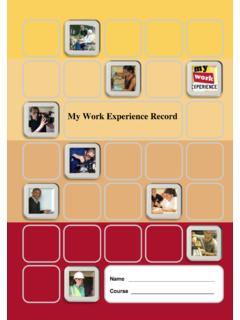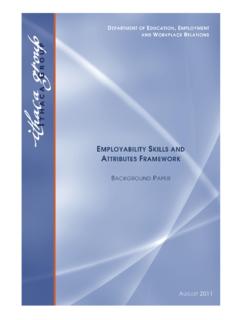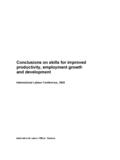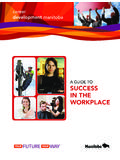Transcription of OCR LEVEL 3 CAMBRIDGE TECHNICAL
1 communication AND employability skills FOR ITF/601/7233 LEVEL 3 UNIT 1 GUIDED LEARNING HOURS: 60 UNIT CREDIT VALUE: 10 OCR LEVEL 3 CAMBRIDGE TECHNICALCERTIFICATE/DIPLOMA AND employability skills FOR ITF/601/7233 LEVEL 3 UNIT 1 AIM OF THE UNITC ommunication is a vital skill for any individual. The effective use of communication and flexibility of styles is a highly desirable attribute to employers to maintain good working practice. This unit identifies the principles for effective communication and introduces learners to the interpersonal skills and attributes required within a work place and how different combinations and approaches are required for a range of job roles it also identifies the different IT tools available for safe and secure communication and exchange of information within an organisation.
2 Learners will consider approaches and adapt the way they communicate, depending on their audience. This unit will prepare learners to effectively use various communication channels, within a working environment and to understand what an employer expects of an individual and how to communicate effectively whilst developing their own personal development and employability skills for IT LEVEL 3 Unit 11 Understand the personal attributes valued by employers 2 Understand the principles of effective communication3 Be able to use IT to communicate effectively 4 Be able to address personal development needsP1 explain the personal attributes valued by employers P2 explain the principles of effective communication P3 discuss potential barriers to effective communication P4 demonstrate a range of effective interpersonal skills P5 use IT to aid communications P6 communicate TECHNICAL
3 Information to a specified audience P7 produce a personal development plan P8 follow a personal development plan M1 explain the different personal skills that employers may require for specific IT job rolesM2 explain the choices of the IT used M3 identify primary areas for improvement and how these will be achievedD1 explain how some of the potential barriers can be reducedD2 justify the use of the IT used to aid communicationLearning Outcome (LO) Pass Merit Distinction The assessment criteria are To achieve a merit the To achieve a distinction the pass requirements for evidence must show that, the evidence must show this unit. in addition to the pass that, in addition to the pass criteria, the learner is able to: and merit criteria, the The learner will: The learner can: learner is able to.
4 ASSESSMENT AND GRADING CONTENTThe unit content describes what has to be taught to ensure that learners are able to access the highest which follows an details what must be taught as part of that area of which follows an is illustrative, it should be noted that where is used , learners must know and be able to apply relevant examples to their work though these do not need to be the same ones specified in the unit Understand the personal attributes valued by employers Personal attributes ( self motivation, leadership qualities, respect, dependability, punctuality, problem solving, determination, independent workers, time management, team working, written numerical and verbal skills , planning and organisational skills ) Good working practices ( Health and Safety, following organisational procedures, adhering to legislation) Specific IT job sectors and personal skills required for the roles ( Networking, Computer gaming, Computer graphics and animation, Programming, Web design).
5 LO2 Understand the principles of effective communication Interpersonal skills ( verbal conversation, lip reading, signing) Cues in verbal exchanges ( body language, use of intonation, nodding, summarising and paraphrasing) Barriers to effective communication ( language, distraction, noise, lack of concentration) Questioning techniques ( closed, open, probing questions, response times) Written communication ( emoticons, note taking, reports, letters, faxes, email) Proofing documents ( grammar checking, spell checking, proofreading, punctuation). LO3 Be able to use IT to communicate effectively communication technology presentation software word processing email web blogs/vlogs instant messaging video conferencing/podcasting.
6 Document Proofing proof reading spelling and grammar checking punctuation. Effective communication understanding the audience adapt information to target audience clarification of requirement ( discussion, meetings, questioning, research).LO4 Be able to address personal development needs Identification ( self assessment, appraisal meeting notes, feedback, performance data) Recording needs ( target setting, appraisal records, performance management reviews) Addressing needs ( work shadowing, team meetings, training, conferences) Learning styles and characteristics ( active or reflective, visual, auditory or physical) Preparing a well structured CV and application ( focussed, accurate, relevant, proofed).
7 5 communication and employability skills for IT LEVEL 3 Unit 1 DELIVERY GUIDANCEU nderstand the personal attributes valued by employers Learners should be taught the attributes that an employer values if possible managers from local companies could come in for a visit and talk to learners regarding company expectations and the responsibilities of the company in terms of Health and Safety and their other statutory legal requirements. Learners should be encouraged to visit local companies to see how they operate and talk to employees as to the expectations that the company has on them to understand different working practices. They may wish to talk to friends and family who work or interview them as to the expectations of their company and job roles.
8 Learners should consider different requirements for different areas of the IT industry this may be network managers/technicians, game designers, programmers etc. Learners should be given job advertisements in local/national newspapers and recruitment websites to review, to gain an understanding of the job requirements, skills and qualifications involved in getting these positions. These requirements should be discussed with the tutor and other members of the should also be taught about their responsibilities as employees within a workplace and the legislation that affects the workplace and them as individuals. They should research this, looking at contracts of employment to appreciate the behaviours they would need to apply when employed in any the principles of effective communication Learners must be taught about communication and the barriers to it.
9 They should identify examples of where accuracy of communication is essential and could engage in role play in order to communicate specific information. They must explore different forms of communication and this is most effective when learners are trying to communicate the same message face to face and then over a telephone and note what they thought with no visual clues as to what the other is saying. This identifies effective communication styles and skills and raises awareness of which methods of communication are most appropriate for given situations and is a good basis for group discussion. Learners also need to be taught how to elicit information from others to gain information for a purpose. Learners could work in teams to pose questions and answers to the rest of the class to see how they can gain the best responses and the required information.
10 They can also research cultural differences in communication how certain countries treat a business card when meeting a new person in practice their interpersonal skills learners could be interviewed in mock interviews for a job or further study by a board of interviewers. This could be video recorded and replayed to allow learners to identify where they can make improvements. Learners can role play communicating with some one older/younger than themselves and should discuss how they would change their language to suit the audience. Learners should be taught to use different written forms of communication and about formal and informal writing. They should be taught to check their work and be given electronic and printed documents that can be proofread and checked to find errors.











